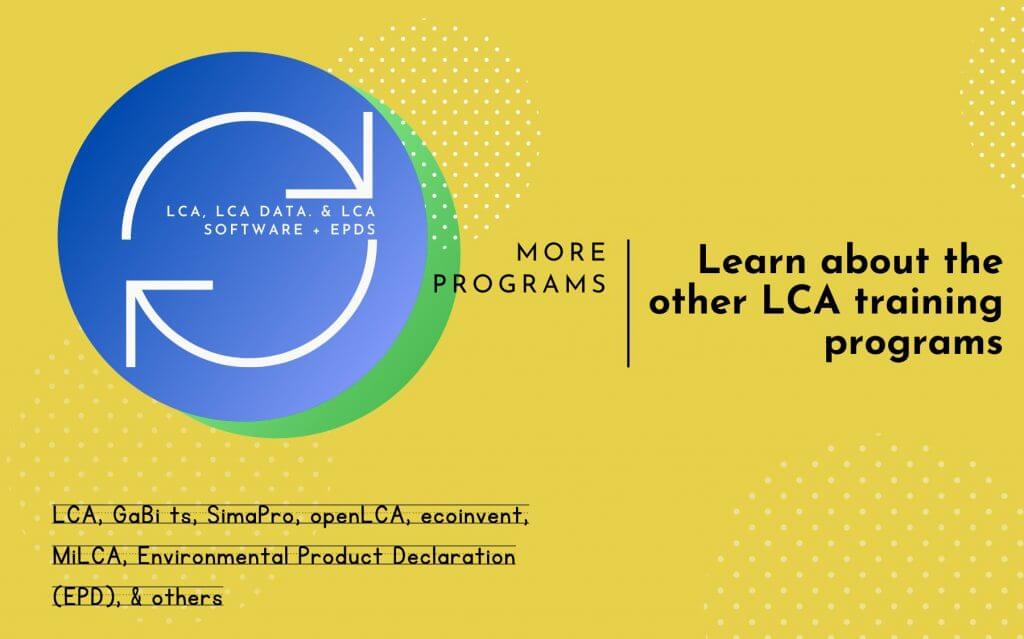18 Hours. 8 Training Modules remotely or in person.
MiLCA LCA Professional Training Program/Course
Price Per Trainee
(Request a Quote for 2+ Trainees).
- 18 Hours of Training
- English Training
- Remote Training
- Flexible Scheduling
- One-to-One or One-to-Group training
- In-Person at DEISO's location
- In Japan at the client location
- Outside Japan: in the client location
- Free "My DEISO" Account (my.dei.so)
Program Description:
Designed for individuals and companies, this MiLCA training course is delivered online or in person by a DEISO Life Cycle Assessment (LCA) expert. Basic and advanced topics in MiLCA and associated database principles are covered throughout the course. (1) Each module’s PowerPoint content, visualization content, case studies from academia and business, participant-instructor interaction, and assignments make up the course. Reference materials are accessible through the DEISO training site at training.dei.so and can be provided during and after the training. The resources contain PDF files with thorough explanations of each module DEISO supplied for this course. The trainer teaches the participants remotely and in real-time using MiLCA installed on the PC(s) of the audience in person at DEISO’s training facilities or the client company’s physical location.
Level
This software ranges in difficulty from beginner to advanced. It is appropriate for individuals with fundamental background knowledge and those without prior experience with MiLCA. Though it focuses primarily on the industry, this course is excellent for all fields (system processes and production). A fundamental understanding of LCA is necessary. The trainer will deal with the participants’ diverse backgrounds.
Required Background
No MiLCA background is required for this program. An experience in LCA is needed.
Services Offered with No Extra Cost:
This training comes with these free services free the training is complete. Our clients are encouraged to take advantage of them.
- The trainer can answer any of the trainees’ questions through an all-to-one remote meeting during the first seven business days (the Japanese work calendar) after the training is completed for up to four hours in two sessions.
- Six hours of three e-meetings (2 hours of each) of consultation on an LCA project using MiLCA of a client during the first month after the training is completed and during the business days (the Japanese work calendar).
- Module 01 (4 hours)
Getting started:
- A brief introduction to LCA.
- Why the use of LCA software?
- LCA software and data gaps.
- Getting started with MiLCA.
- Exploring the user interface, the features, the potentials, and the data.
- Introduction to processes.
- What are emission factors?
- Required data: background and foreground data-what are the differences and how they impact the results? How to develop a strategy for data collection.
- An LCA model: Inputs and outputs, materials, energy, waste, and emissions.
- Foreground data: from the factory, experiment, simulation, and literature to MiLCA.
- How to design an LCA model.
- Bringing the design to MiLCA.
- Module 02 (1 hour)
IDEA database: An introduction to the Inventory Database for Environmental Analysis (IDEA) database and with a comparison with other available Life Cycle Inventory (LCI) databases.
- Module 03 (4 hours)
Process management:
- Finding, exploring, and browsing the processes of the database.
- Understanding the documentation of each process, its boundaries, and scops. Understanding the process tree and its inventory (emissions and its emission factors).
- Learn about the process flows, how to properly create a process, and how to export its content. Learn the differences between the “process” and the “product” and how to use the process flows.
- Understanding the functional unit and how to decide a proper one for the modeled system.
- Exploring the grid electricity processes and how to define them in the model.
- Creation of processes for transportation and energy and how to express their variables.
- Learn how to create a process with co-product using waste treatment routes.
- Get a deep understanding and learn the differences between production processes and end-of-life ones (such as the landfilling processes).
- Learn how to create and use processes for co-products of an output product with cut-offs.
- Learn how to create region-specific data.
- How to build a process from BOM data and register them in bulk.
- Module 04 (2 hours)
Calculations: Learn how to calculate the inventory and perform an impact assessment using the Life Cycle Impact Assessment (LCIA) methods.
- Module 05 (5 hours)
LCA modeling:
- Modeling two case studies from system design to data collection and building a cradle to gate or a cradle to grave model with subsystem editing, and product flow editing.
- Perform calculations and explore the results in various formats, including visualized ones.
- Learn all about weighting. Understanding the weighting factors, developing weighting factors, and how to weigh the results.
- Learn how to score the weighted results for a straightforward approach of easy-to-understand.
- Module 06 (4 hours)
Interpreting results:
- This module helps to understand LCA results. By looking at the overall system (the model) and specific processes of the system. Rather than to just only gain an outlook of the system, you will learn how to identify the hotspots of the entire model. There are several ways of presenting LCA results. We will provide examples of LCA results to show how you need to take care of how results are presented and interpreted and what to look at and use tools such as Microsoft Excel, Tableau, and the suitable graphs to look at each part of the system. We also focus on how to understand the inventory results (the emission amounts) and their emissions medium: to air, water, and soil (industrial and agricultural soil). We pay special attention to GHG emissions, especially Carbon Dioxide.
- Get a deep understanding of the product system, the inventory analysis, the impact assessment, and how to interpret the basic results.
- Learn how to identify the weak points of the system and how to address opportunities for improvements.
- Module 07 (2 hours)
Other topics:
- Using import and export of processes and projects.
- Team building.
- How to export the results to MS-Excel for further analysis and data visualization.
- How to deal with missing LCI data, data estimation approaches, how to extract emission factors of materials, energy, and waste from literature and technical reports.
- Further topics for learning: an introduction to sensitivity and uncertainty analysis.
- Module 08 (2 hours)
Reporting the results: Learn how to report the result. How to write a report based on the LCA ISO standard.
What Will You Learn?
- This course’s exclusive focus on utilizing MiLCA to do LCA modeling is one of its distinguishing features. Additionally, it covers system processes of I/O in-depth, data collection, and how to employ the correct procedures for the full model. How to handle problems like missing data, gathering information from literature or industry reports, etc. Additionally, it considers data estimating techniques when Life cycle Impact Assessment (LCI) data are lacking for a particular process.
- This training’s integration of the LCA idea as a theory on a complete practice with the software is another special feature. The purpose of the training is to instruct participants on how to utilize the software in accordance with the best LCA ISO standard practices.
Expected Outcome: By completing this training, a participant is expected to have a complete understanding of modeling with MiLCA and using its data. Has a solid knowledge of LCI, data collection and insertion, and how to model an entire system with the software.
You have the choice to opt for the certificate, though there are additional fees for examination and certification.





